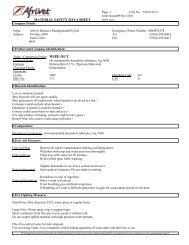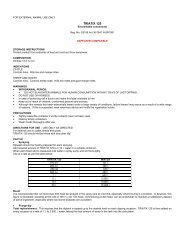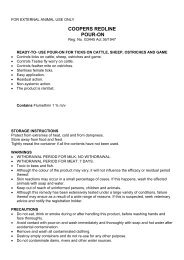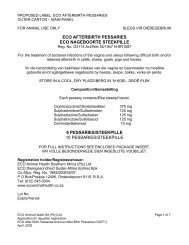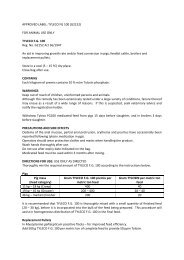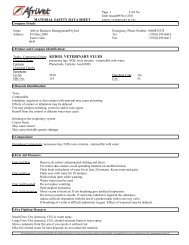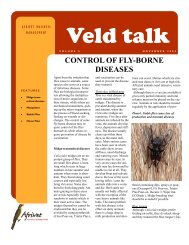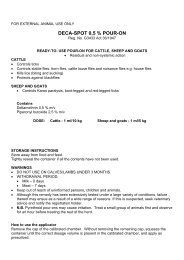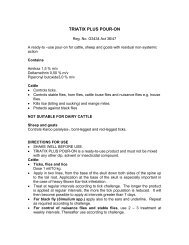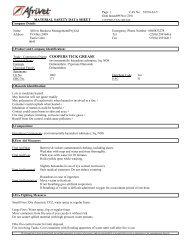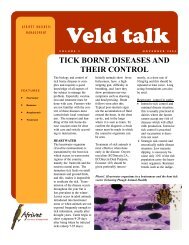Clostridial diseases of cattle.pdf - Afrivet
Clostridial diseases of cattle.pdf - Afrivet
Clostridial diseases of cattle.pdf - Afrivet
You also want an ePaper? Increase the reach of your titles
YUMPU automatically turns print PDFs into web optimized ePapers that Google loves.
AFRIVET BUSINESS<br />
MANAGEMENT<br />
Veld talk<br />
V O L U M E 9<br />
CLOSTRIDIAL DISEASES OF CATTLE<br />
FEATURES<br />
• Quarter evil<br />
• <strong>Clostridial</strong> intestinal<br />
infections in<br />
calves<br />
• <strong>Clostridial</strong> intestinal<br />
infections in<br />
adult <strong>cattle</strong><br />
• Botulism<br />
• Tetanus<br />
• Use <strong>of</strong> vaccines<br />
The importance <strong>of</strong> clostridial<br />
<strong>diseases</strong><br />
Diseases caused by Clostridium bacteria<br />
are responsible for large numbers<br />
<strong>of</strong> losses in <strong>cattle</strong>. The bacteria<br />
are widespread in nature and in the<br />
intestines <strong>of</strong> animals and people,<br />
but not all cause disease. Some are<br />
involved in the spoilage <strong>of</strong> food and<br />
the decomposition <strong>of</strong> carcasses. The<br />
clostridia that cause animal <strong>diseases</strong><br />
occur in the environment and<br />
cannot be eradicated. Control must<br />
focus on prevention by vaccination<br />
as clostridial <strong>diseases</strong> have a rapid<br />
course and seldom allow time for<br />
diagnosis and treatment.<br />
Gas gangrene (Quarter evil )<br />
The syndrome known as blackquarter<br />
or quarter evil is a gangrenous<br />
infection <strong>of</strong> the muscles <strong>of</strong> the body.<br />
There are a number <strong>of</strong> different<br />
clostridia which can cause the syndrome<br />
but C. chauvoei is the most<br />
common cause. Other clostridia<br />
which cause quarter evil are C. septicum,<br />
C. novyi and C. sordelli.<br />
The disease occurs mostly in young<br />
<strong>cattle</strong> <strong>of</strong> after weaning age until<br />
roughly 3 years <strong>of</strong> age but cases can<br />
be seen in older animals. The organisms<br />
penetrate the muscles <strong>of</strong> <strong>cattle</strong><br />
in the form <strong>of</strong> spores and remain dormant<br />
until the conditions in the muscle<br />
become suitable for their germination<br />
(it is still unknown what the precipitating<br />
factor is). The bacteria germinate<br />
and produce toxins which kill <strong>of</strong>f<br />
the muscle tissue, and spread throughout<br />
the body causing death <strong>of</strong> the animal.<br />
The large muscles <strong>of</strong> the hindquarter<br />
are usually affected but occasionally<br />
the heart, diaphragm and tongue muscles<br />
are affected.<br />
Cattle with quarter evil show stiffness<br />
and discomfort but the disease is seldom<br />
diagnosed at this stage and animals<br />
die acutely. Characteristically animals<br />
that have died <strong>of</strong> quarter evil<br />
have swollen carcasses due to gas formation<br />
and rapid decomposition. On<br />
post-mortem the affected muscles are<br />
dark red to black when cut, and have a<br />
rancid smell in cases <strong>of</strong> C. chauvoe infection.<br />
The diagnosis <strong>of</strong> quarter evil is confirmed<br />
on post mortem by taking bacterial<br />
samples <strong>of</strong> muscle tissue. The<br />
most economic and effective control is<br />
done by vaccinating with multicomponent<br />
clostridial vaccines, such as<br />
Covexin 10 which contain all the causative<br />
strains.<br />
Acute deaths caused by clostridial gas<br />
gangrene can be confused with anthrax<br />
cases. If anthrax is suspected, a blood<br />
smear must be examined by a vet be-
PAGE 2<br />
fore the carcass can be<br />
opened up. The muscle lesions<br />
caused by gas gangrene<br />
may also be confused<br />
with snakebite<br />
wounds.<br />
Clostridium perfringens<br />
intestinal infections in<br />
calves<br />
Calves on a high level <strong>of</strong><br />
nutrition can develop gastro-intestinal<br />
conditions<br />
caused by C. perfringens<br />
bacteria. A syndrome<br />
which is typified by sudden<br />
deaths and abomosal<br />
ulcers and termed “red<br />
gut” has been tentatively<br />
associated with C. perfringens<br />
type A. Although<br />
this organism has been<br />
included in multiclostridial<br />
vaccines, the manufacturers<br />
don’t claim protection<br />
against this syndrome.<br />
Newborn calves can develop<br />
necrotic enteritis as<br />
a result <strong>of</strong> C. perfringens<br />
type C. They show depression,<br />
weakness and may<br />
develop bloody diarrhoea.<br />
On post-mortem examination<br />
bleeding and necrosis<br />
<strong>of</strong> the gut may be seen.<br />
C. perfringens type D, the<br />
cause <strong>of</strong> pulpy kidney in<br />
sheep, can cause an<br />
“overeating syndrome” in<br />
calves although it is fairly<br />
rare. On post mortem the<br />
calves show kidney and<br />
brain damage. The syndromes<br />
caused by types C<br />
and D, can be prevented<br />
by vaccination with multicomponent<br />
clostridial vaccines<br />
such as Covexin 10.<br />
Photo 1: The kidney <strong>of</strong> a calf<br />
that died <strong>of</strong> “overeating syndrome”<br />
caused by C. perfringens<br />
D.<br />
Clostridium perfringens<br />
intestinal infections in<br />
adult <strong>cattle</strong><br />
It has been suggested that<br />
the “red gut” syndrome<br />
seen in feedlot <strong>cattle</strong> in<br />
South Africa is due to a proliferation<br />
<strong>of</strong> C. perfringens<br />
type A in the intestine.<br />
Similar conditions have<br />
been described in the USA<br />
as “jejunal haemorrhagic<br />
syndrome”. The disease is<br />
acute, characterised by loss<br />
<strong>of</strong> appetite, bloat, haemorrhage<br />
in the gut and rapid<br />
deaths. Predisposing factors<br />
are possibly the high intake<br />
<strong>of</strong> concentrates and low<br />
roughage intake. There is<br />
no successful treatment for<br />
the treatment for the condition.<br />
The use <strong>of</strong> vaccines for<br />
this condition is controversial<br />
although the organisms<br />
are included in certain vaccines.<br />
It is suggested that<br />
feed management can control<br />
the syndrome, namely<br />
consistent feeding especially<br />
with regard to the<br />
quantities, and restricting<br />
water intake after feeding.<br />
C. perfringens type A is included<br />
in some multicomponent<br />
vaccines because<br />
the organism causes wound<br />
infections, the so-called gas<br />
gangrene which also occurs<br />
in humans.<br />
Photo 2: “Red gut” may be precipitated<br />
by certain feeding<br />
practices which cause an overgrowth<br />
<strong>of</strong> C. perfringens A.<br />
Botulism<br />
C. botulinum bacteria occur<br />
widely in the environment<br />
and grow in carcases.<br />
The bacteria produce a<br />
powerful toxin which is<br />
responsible for the clinical<br />
symptoms <strong>of</strong> botulism.<br />
Botulism in <strong>cattle</strong> occurs<br />
either in <strong>cattle</strong> on winter<br />
veld (C.botulinum type D)<br />
or when the feed <strong>of</strong> animals<br />
becomes contaminated<br />
by animal carcasses<br />
(C. botulinum type C).<br />
During late summer and<br />
VELD TALK
VOLUME 9<br />
PAGE 3<br />
winter the phosphate levels<br />
<strong>of</strong> veld grass begin to drop.<br />
Cattle develop a phosphate<br />
hunger or “pica” which<br />
causes them to eat old bones<br />
or tortoise shells which can<br />
contain botulism toxin. In<br />
kraal conditions feed can be<br />
contaminated when small<br />
animals like rats, birds and<br />
cats die and contaminate the<br />
feed with botulism toxin.<br />
Broiler manure is very commonly<br />
contaminated because<br />
it almost always contains<br />
chicken carcasses.<br />
Once <strong>cattle</strong> have ingested<br />
botulism toxin the symptoms<br />
will be seen in 2-6 days. The<br />
first signs that are noticed<br />
are weakness in the hind<br />
limbs, and then paralysis <strong>of</strong><br />
the throat and jaw. Animals<br />
are unable to swallow and<br />
saliva streams from the<br />
mouth. Because they cannot<br />
swallow, attempts to dose<br />
animals will cause gangrenous<br />
pneumonia as the remedies<br />
will end up in the lungs.<br />
As the condition progresses,<br />
animals are eventually unable<br />
to stand and lie down<br />
with their heads held against<br />
their bodies. Eventually the<br />
breathing muscles are affected<br />
and the animal dies. A<br />
post-mortem will reveal<br />
nothing specific and confirmation<br />
can only be done by<br />
isolating the toxin from the<br />
gut.<br />
Treatment with botulism<br />
antiserum can be attempted<br />
but it is seldom successful<br />
except in very early cases.<br />
The most economical control<br />
measure is vaccination. Supplementation<br />
with phosphate<br />
licks in winter will<br />
reduce eating <strong>of</strong> bones and<br />
will improve the condition<br />
<strong>of</strong> animals.<br />
The symptoms <strong>of</strong> botulism<br />
can be confused with Diplodea<br />
poisoning (a fungus which<br />
grows on mealies),<br />
“krimpsiekte” plant poisoning,<br />
rabies, and three-day stiffsickness.<br />
Photo 3: A case <strong>of</strong> botulism in a<br />
bovine<br />
Tetanus<br />
Cattle are not very susceptible<br />
to Clostridium tetani bacteria,<br />
but cases do occur after<br />
surgical procedures such as<br />
dehorning. C. tetani bacteria<br />
occur in the faeces <strong>of</strong> animals<br />
and enter wounds very easily<br />
under unhygienic conditions.<br />
The bacteria grow well in deep<br />
wounds, where they produce a<br />
powerful toxin which affects<br />
the nervous system <strong>of</strong> the animal.<br />
Initially, affected animals<br />
show stiffness <strong>of</strong> the legs,<br />
which they hold far from their<br />
bodies as if trying to balance.<br />
The third eyelid may collapse<br />
across the eye, and the animals<br />
are constipated and depressed.<br />
In the terminal stages they develop<br />
spastic (jerky) paralysis.<br />
Eventually they die when the<br />
respiratory muscles become<br />
paralyzed.<br />
Treatment <strong>of</strong> affected animals<br />
with antibiotics is usually too<br />
late as the toxin has already<br />
been produced. The use <strong>of</strong> tetanus<br />
antiserum is also usually<br />
not very effective unless given<br />
early in the course <strong>of</strong> the disease.<br />
Since <strong>cattle</strong> are less susceptible<br />
than sheep or horses,<br />
they are not usually vaccinated<br />
against tetanus but control<br />
measures such as stringent<br />
wound hygiene must be<br />
practiced when doing dehorning,<br />
ho<strong>of</strong> paring and any other<br />
surgical interventions. Sterile<br />
instruments and wound disinfection<br />
must be used. Tetanus<br />
in <strong>cattle</strong> can be confused with<br />
laminitis, and certain plant<br />
poisonings, and in the late<br />
stages with heartwater.<br />
Photo 6: Tetanus in a calf
THE USE OF INACTIVATED VACCINES<br />
<strong>Clostridial</strong> vaccines are all inactivated vaccines and when used<br />
there are certain guidelines that must be followed.<br />
Handling: inactivated vaccines are more stable than live vaccines<br />
but nevertheless must be stored in a refrigerator at a temperature<br />
between 2 and 8 o C, but never frozen. If this happens by accident<br />
the vaccine must be discarded. Do not accept vaccines that<br />
have been stored on co-op counters or transported without cool<br />
packs over long distances. Inactivated vaccines usually contain<br />
an adjuvant which settles whenever the bottles have been standing<br />
for some time. Before injecting the vaccine ensure the bottle<br />
is shaken thoroughly to suspend the adjuvant evenly. Once<br />
opened and used, vaccine bottles should be discarded because vaccine<br />
can become contaminated during use. Contaminated vaccine<br />
is a potential cause <strong>of</strong> infections and may even become ineffective.<br />
Administration: inactivated vaccines seldom give effective protection<br />
after a single inoculation. They must be boosted a month<br />
after the initial injection and thereafter require an annual revaccination.<br />
Vaccination must be done timeously before the exposure<br />
<strong>of</strong> the animals to disease. Most clostridial vaccines are therefore<br />
given at weaning age. Cattle must only be fed chicken manure<br />
two weeks after the two initial vaccinations against botulism.<br />
Unlike many live vaccines inactivated vaccines will not be<br />
affected by the admistration <strong>of</strong> antibiotics.<br />
Hygiene: as with all vaccines good needle and syringe hygiene are<br />
absolutely essential: needles and syringes must be sterilised in<br />
boiling water for a minimum <strong>of</strong> 15 minutes before use. Disinfection<br />
with alcohol or other disinfectants is not suitable. Infected<br />
needles and syringes can causes abcessation at injection sites and<br />
even fatal septicaemias.<br />
Dr Pamela Hunter



